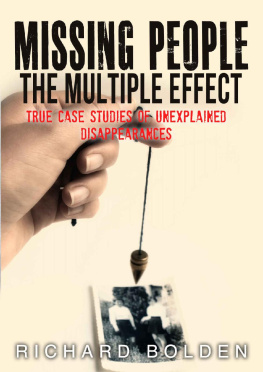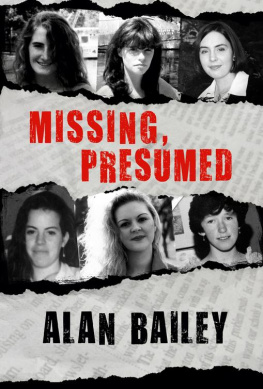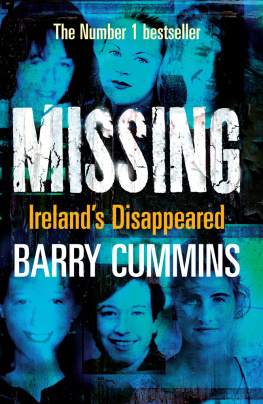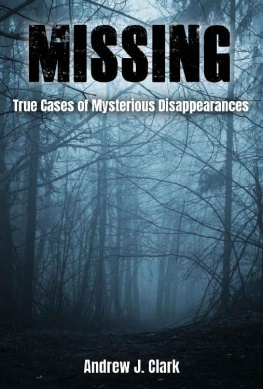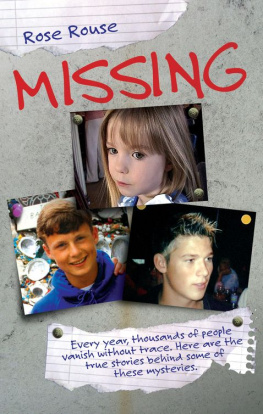MISSING PEOPLE
THE MULTIPLE EFFECT
True Case Studies Of Unexplained Disappearances
Richard Bolden
Table of Contents
Introduction
Morgues in the US have a startling 40,000 unidentified bodies. Many of these remains are kept on hand in case they can be given back to their family members. Unfortunately, not all can be kept due to the constraints of space, thus potter's field locations are set up. Whenever a body is unmarked with no name and no identification options, the morgue system will keep DNA and other samples on hand. But even that is a difficult job. Most morgues have the space to keep blood, DNA, and other samples for only a year. With thousands of new cases of unidentified remains occurring each year, it was necessary to start websites like NAMUS and Missing Person's of America. It was also imperative to have databases that will keep DNA and other tests on record. In the event the DNA gets added to the system of a known person, it can be matched with the databases. According to the Department of Justice, 86,000 missing people are in the National Crime Information Center Database.
When family members go missing, one of the first things remaining family will do is submit their DNA to the database. They also make sure to provide a sample of the missing person, such as a hair or other sample from items they left behind. Yet law enforcement still struggles to keep up with the high number of new cases. They still have to rely on luck that remains, witness statements, or other evidence will come in that they can match with an open, cold case. Several families have already gone decades hoping for answers without getting them.
What makes multiple disappearances so rare is the method required to make more than one person go missing at the same time. It requires planning, whether the disappearance is willingly or due to foul play. Someone who commits unpremeditated murder usually leaves the bodies behind as evidence because of panic and a lack of planning. Those who intentionally conduct foul play, such as murder, kidnapping, or robbery, also tend to leave the bodies behind.
Although rare, there are cases in which multiple people, such as two to four people from the same family or group of friends, will go missing without any evidence or indication as to what occurred. These startling tales are included within these pages. Be wary and always alert the next time you go out, whether you are alone or with a group of people because you never know what might happen.
Chapter 1:
The Indiana Dunes Women
Indian Dunes State Park was filled with nearly 9,000 holiday sunbathers on July 2, 1966. It was a Saturday at noon, when a couple saw three women getting into a boat with a man. These three women were Ann Miller, Patricia Blough, and Renee Bruhl. The three friends had driven up from Chicago to Indiana Dunes State Park to enjoy the beach and Lake Michigan.
The couple who watched the girls felt it was odd that they would leave their purses and beach blankets on the crowded beach. They didn't know the girls, but figured they would watch over their items until they came back. At dusk the couple told a ranger watching over the park that the blanket and belongings were left behind. They indicated to the ranger that they had watched three girls get on a boat that was operated by a man with coal-colored hair and tan skin. The range bundled up the items and brought them to the ranger hut to store them in the lost and found.
Ann Miller was 21 years old. Both Patricia and Renee were 19 years old. The man, the boat, and the three girls have never been seen since July 2, 1966. In July 4, 1966 just 18 hours after the ranger gathered the girls' belongings, Bill Svetic received a phone call. Park Superintendent Svetic received an inquiry from Mr. Blough, Patricia's father. He had not heard from her since she and her two friends left Chicago to go to the park Saturday morning.
Svetic instantly went to the blanket to see what he could find. He found Patricia's wallet, keys, clothing, and her companions clothing and purses. Miller's 1955 Buick was also discovered in the parking lot. It was just one of 2,200 cars which had entered the park on Saturday. Knowing the witnesses had stated the girls went with a guy on his boat, he told Mr. Blough that Patricia would probably turn up after the long weekend.
After the weekend and now more than 48 hours missing, Mr. Blough was finally able to get an investigation going into his daughter's disappearance. Scuba teams took to the lake running a search grid, while other foot and horseback patrols went up and down the wooded park area that runs along the 45 mile long coastline of Indiana. No sign was found, and their case remains open as one of the longest Midwest crime mysteries.
A news reporter, Dick Wylie, worked for the Gary Post Tribune and Chicago Sun Times during the 50s and 60s. He was the first reporter to come to the park when the three girls went missing. He has a 120,000 word manuscript, as well as countless pages of notes, police files, and interviews he conducted trying to find any evidence as to the three girls' disappearance.
Wylie's Theory
Blough and Miller were both single. According to Wylie they were dating married men at the tavern where they worked. There was also evidence to suggest both were pregnant. Bruhl was married, but her married life did not seem to be filled with roses. When investigators found Bruhl's purse, there was a letter addressed to her husband asking for a divorce. She never got around to mailing it.
At the time only one cop in Westchester, Illinois was conducting background checks on the girls because it was their hometown. A state detective was searching the park for clues. This meant that not a lot of manpower was being used to find the three women. According to Wylie, the two cops never even met, even though they were working the same case. For Wylie, he felt the two women's pregnancies were the clues to the entire case.
Abortion was illegal in Illinois. Many Chicago women who became pregnant without fathers tended to visit a house in Gary, Indiana. At the house Helen and Frank Largo would perform backroom abortions. Wylie was also able to link the married couple to a floating abortion mill, which was operated on a houseboat just offshore in Lake Michigan. Wylie believes the three girls went with a young relative of Helen and Frank Largo to go to the houseboat for abortions.
Wylie believes that something must have gone wrong with one of the girls during the operation and rather than leave two witnesses, the other two girls were killed. Wylie said his investigation indicated the girls thought they would be back in 90 minutes, so they left their items on the beach.
Did the two women intend on getting abortions? Did the boat with the young man capsize and everyone died trying to get back to shore? With no clues in over 46 years, it is likely that an answer will never be found. If foul play was involved, then three skeletons may still be weighed down with whatever was handy to ensure the crime remains unsolved.
Chapter 2:
The Fort Worth Three
Mary Rachel Trlica, Lisa Renee Wilson, and Julie Ann Moseley have something in common. They all went missing on December 23, 1974 from Fort Worth Texas. Mary Rachel was just 17 years old when she went shopping with Lisa Renee, 14 years old; and Julie Ann, 9 years old. The three girls went to the Seminary South Shopping Center to do some last minute Christmas shopping.
The vehicle Mary Rachel was driving was found at 6 p.m. in the mall parking lot. The car was locked and Christmas presents were inside. The presents indicate the girls returned to the car at least once to drop off the items they had purchased, but were they done with their shopping? Did they return to the mall or did something happen when they put the shopping bags in the car?
Next page
